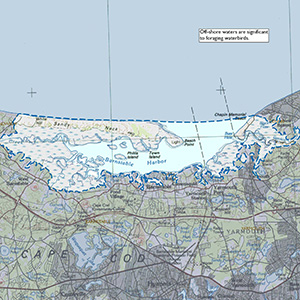Important Bird Area: South Cape Beaches - Sandy Neck
Site Summary
Nominated By
Matt Bailey, Scott Hecker
Size
10 acres
Towns and Counties
Barnstable, Sandwich; Barnstable
Ownership
municipal, private, The Nature Conservancy
Major Habitats
pitch pine/scrub oak, maritime heathland/sandplain grassland, salt marsh, coastal beach, marine/tidal, migratory stopover site, interdunal wetland swales
Land Use
nature & wildlife, conservation/ land trust, other recreation or tourism, fisheries/aquaculture, research, undeveloped
IBA Criteria
- Category 1: Sites important for long-term research and/or monitoring projects that contribute substantially to ornithology, bird conservation, and/or education.
- Category 5: Shorebirds: The site regularly supports 1,000 or more shorebirds at one time at a coastal site, during some part of the year, or a significant concentration of shorebirds at one time at a nontidal site. The designation "shorebirds" includes birds such as plovers, sandpipers, snipe, woodcocks, and phalaropes.
Site Description
Sandy Neck is one of the largest barrier beaches and salt marsh complexes in Massachusetts and runs the full length of the town of Barnstable on Cape Cod Bay. It has one of the most complex combinations of coastal habitats in Massachusetts. There are wooded areas of scrub maritime forest, swales with heath and freshwater wetland, and very high and extensive dunes. A small community of cottages is located near the end of the site on Barnstable Harbor. The front beach is heavily traversed by off-road vehicles and includes a stretch for camping in recreational vehicles. The cottages and parts of the front beach are accessed by a series of sand roads. The southwestern end of the site is bordered by extensive salt marsh that is utilized by a wide variety of shorebirds and marsh birds and also by a well-established aquaculture industry. The Grey's Beach site is a small chain of barrier beach hummocks that sit on a peat ledge on the outer edge of a large expanse of the Yarmouthport area salt marsh just east of the mouth of Barnstable Harbor. The beach is held in place with a cover of beach grass, Dusty Miller, and a few woody shrubs. There is virtually no human visitation of the site other than by Mass Audubon employees engaged in monitoring the terns and shorebirds that nest there.
Current Conservation Status
Most of the beaches are town owned, with the exception of part of Sandy Neck, which is owned by The Nature Conservancy (TNC). Off-road-vehicle use, both for recreation and for access to cottages, has been a subject of debate on Sandy Neck for the past 15 years. Most recently, a state mediator has been employed to work with 16 representatives of the various stakeholders to reach settlement on a state-sanctioned beach management plan by June 2003. Despite this situation, the nesting habitat for Piping Plover has been well protected over the past 15 years and continues to support one of the largest populations for this species.
Ornithological Significance
Sandy Neck regularly hosts more than 20 pairs of nesting Piping Plovers and an average 100 pairs of nesting Least Terns. Pioneering research has been conducted there on Piping Plover protection since 1986. Also the integrity of this site is important to the thousands of waterfowl and migratory shorebirds that depend on the areas it shelters for foraging habitat. Greys Beach is an important breeding site for Common and Least Terns, and occasionally Roseate Terns. Tern and Piping Plover breeding progress has been monitored on Grey's Beach by Mass Audubon's Coastal Waterbird Program for the past 16 years. The tern colony varies in size from several thousand pairs to complete abandonment, depending on nesting success and pressure on the site by predators.
Other Flora or Fauna of Significance
Diamondback terrapin, Eastern Spadefoot Toad.
Data Sources
MassWildlife state Tern Inventories and Piping Plover Reports, extensive records from the files of Mass Audubon's Coastal Waterbird Program, Matthew Bailey, personal observation.




